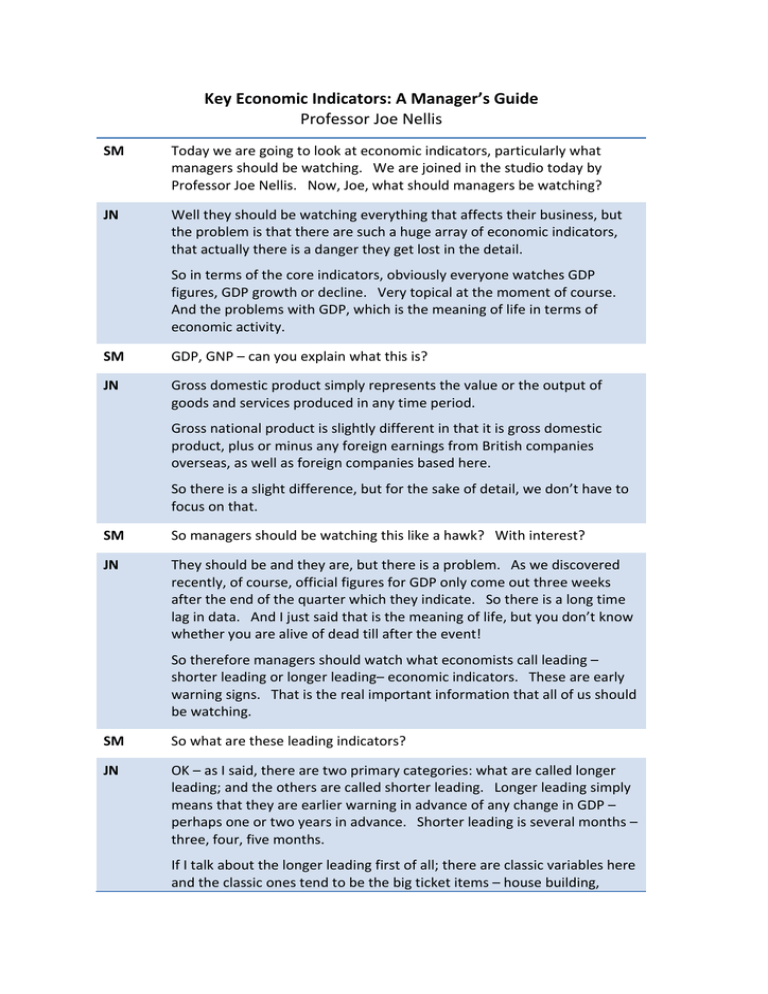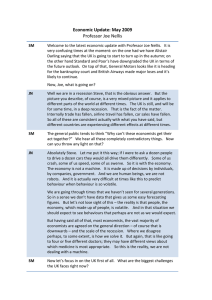Key Economic Indicators: A Manager’s Guide Professor Joe Nellis
advertisement

Key Economic Indicators: A Manager’s Guide Professor Joe Nellis SM Today we are going to look at economic indicators, particularly what managers should be watching. We are joined in the studio today by Professor Joe Nellis. Now, Joe, what should managers be watching? JN Well they should be watching everything that affects their business, but the problem is that there are such a huge array of economic indicators, that actually there is a danger they get lost in the detail. So in terms of the core indicators, obviously everyone watches GDP figures, GDP growth or decline. Very topical at the moment of course. And the problems with GDP, which is the meaning of life in terms of economic activity. SM GDP, GNP – can you explain what this is? JN Gross domestic product simply represents the value or the output of goods and services produced in any time period. Gross national product is slightly different in that it is gross domestic product, plus or minus any foreign earnings from British companies overseas, as well as foreign companies based here. So there is a slight difference, but for the sake of detail, we don’t have to focus on that. SM So managers should be watching this like a hawk? With interest? JN They should be and they are, but there is a problem. As we discovered recently, of course, official figures for GDP only come out three weeks after the end of the quarter which they indicate. So there is a long time lag in data. And I just said that is the meaning of life, but you don’t know whether you are alive of dead till after the event! So therefore managers should watch what economists call leading – shorter leading or longer leading– economic indicators. These are early warning signs. That is the real important information that all of us should be watching. SM So what are these leading indicators? JN OK – as I said, there are two primary categories: what are called longer leading; and the others are called shorter leading. Longer leading simply means that they are earlier warning in advance of any change in GDP – perhaps one or two years in advance. Shorter leading is several months – three, four, five months. If I talk about the longer leading first of all; there are classic variables here and the classic ones tend to be the big ticket items – house building, Professor Joe Nellis obviously; the car industry. And the reason is that these two sectors, in particular, of course impact on so many other sectors and the whole supply chain. There is a ripple effect for many, many months to come as we see a pick up in house building in particular. There are of course many other longer leading indicators and some of these, of course, will represent information that particular sectors look at. One of the most important ones tends to be the purchasing managers’ index. For some sectors, it’s longer leading; for other sectors it may be relatively short term. It’s what purchasing managers in companies are monitoring in terms of their order books, their supply chains. SM I can’t help wondering that if the average manager says, all these figures are really confusing, and anyway did economists really predict ahead that this crisis was coming? JN Well, I totally understand the confusion on the part of managers. Indeed many of us economists are also confused, because as I said before, we now have more information at our fingertips than ever before. People are much more aware of economic indicators. Did we predict the downturn? Yes we did. But this downturn has special characteristics. I think few, if anybody, expected the collapse of bank lending in the way that it happened. But this wasn’t a matter of predicting the economy, this was a matter of predicting the behaviour of banks and the way in which regulation was being implemented. Now you could argue, is that an economic issue or a regulatory issue? Or are they the same? I would argue strongly that economists can be excused for not spotting this because the regulatory system had become so hands off, so relaxed in terms of checking the balance sheets of banks and maybe non‐ exec directors are more responsible than economists in failing to predict what was about to happen. SM So let’s get back to the company manager – what are the key checklist of indicators that they need to bear in mind? JN As I said, there are many. Examples I have given already: house building activity, car industry; obviously inflation figures; wage levels – all of these are critical. But also particular aspects such as stock levels. Let me spend a few minutes on stock levels – inventories as Americans call them. If, in general, industry has experienced an increase in stock levels and these increases were not expected, this is bad news. Stock levels rise unexpectedly because sales are falling unexpectedly; and of course, manufacturing in particular will not go on producing as much, as long as those stocks are rising or not falling. This is what is referred to in economics as the stock adjustment model. So until we see the levels of stocks in house building – the existing stocks – in the car industry and many other sectors and until those stock levels start to come down, we are going to see output continue to stagnate. Now that is a key indicator Page 2 Professor Joe Nellis right now. But as I say, there are many others. There is a critical one which is referred to as capacity utilisation. It’s really a survey asking firms are you operating at or below full capacity? At the moment in the UK, of course, many firms are below full capacity and therefore they have spare capacity, which again, is a sign that things will not pick up in the short term. It’s going to be 12 to 18 months before we see that spare capacity absorbed and then we are back on some sort of trend. SM A lot of the headlines have been saying that unemployment is rising dramatically – is this important in this context? JN Well first of all, unemployment is rising sharply and will probably head over the 3 million mark by the time we come out of this recession. It is very important of course for those people who are unemployed, but in terms of unemployment as an economic indicator, it’s actually not that important which may sound rather harsh. Unemployment is the classic lagging indicator: unemployment does not decline, it doesn’t reverse, until many months after the economy has turned up. That could be anything from 12 to 24 months. So even when we start to see GDP improving, we are almost certainly going to see unemployment rising thereafter, and the reason is very simple. Having downsized, which is a horrible word, but having got rid of labour in many sectors, companies are going to be reluctant to re‐recruit people until they are very confident that the recovery is well established and that their own profits are back on track again. So I think unemployment, to be direct, is not a helpful lead indicator, but it is critical to those people, of course, who are unemployed. SM So if you were to leave managers with a message about key indicators, what would it be? JN Well, keep yourself well informed. Subscribe to the CBI survey, they are very important. Use your gut instinct, use your common sense, I suppose. But don’t get bogged down; don’t get overloaded with the micro detail. Of course there is a danger of being superficial as well. But I would also argue spread your messages, spread your readings. Don’t focus on one particular voice because they may be wrong. There are so many forecasts available these days, but we do have consensus surveys produced by the Treasury. They are not the Treasury forecast, they are the collection of other forecasts which gives us perhaps a better balance in our outlook. SM That is useful, thank you Joe. Page 3




